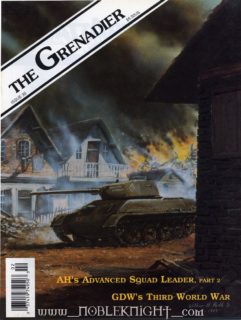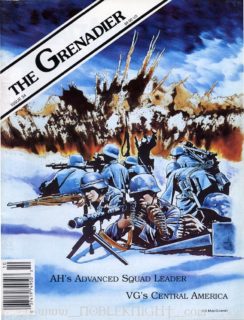In this article we wil take a look at just how the stacking rules have changed over time.
Drang Nach Osten/Unentschieden [1973]
The very first two games in the Europa series introduced the first version of stacking rules. These rules were significantly different from most other Wargames available at the time – revolutionary in fact. Remember that at the time, most games just used a system in which you could stack 1, 2 or 3 units in a hex – regardless of the size of those units. So a Corps could take up as much hex “space” as a Battalion. Obviously, this was a very simplistic approach and DNO/Unt used a significantly different set of rules.
First of all, we have to introduce the concept of Stacking Points [SP]. While these are used for some other purposes, we’ll just look at SP with respect to stacking. In the main, you can think of SPs as largely equating to Regimental Equivalents [Res].
Each side has different maximum totals of SP which can stack in a hex, and for both sides these maximum totals change over time. I won’t be addressing stacking in the Arctic since it is based partially on values printed right on the maps for cities north of the A weather line, and otherwise is just one SP or one unit per hex for both sides, for the entire game.
For the Axis side, from Jun II 41 until Jun I 43, they can stack 10 Stacking Points per hex; from Jun II 43 until the end of the game, they can stack 11 Stacking Points per hex.
SP values for German [not Axis-Allied] units;
- 0 SP Railway Artillery
- 0.5 SP Battalions [totals for Battalions round DOWN, so 3x Battalions = 1 SP, etc.
- 1 SP Kampfgruppen [what would later be termed Cadres], Headquarters, Brigades, Regiments
- 2 SP Motorized XXs w/fewer than 10 combat factors, Mountain & Jaeger XXs
- 3 SP All other XXs.
SP values for Axis-Allied units:
- 0.5SP Battalions [see note above re: German battalions]
- 1 SP Headquarters, Brigades, Regiments, Finnish Ski Patrols
- 2 SP All XXs which are NOT Hungarian or Romanian Infantry XXs
- 3 SP Hungarian & Romanian Infantry XXs
For the Soviets, they have four different maximum SP per hex, as well as exceptions based on on-map city size.
- Jun II 41 – Sep II 41 6 SPs
- Oct I 41 – Sep II 42 7 SPs
- Oct I 42 – Jun II 43 8 SPs
- Jul I 43 – End 9 SPs
Note that the Soviet player can stack up to 10 SPs in any Full hex city and up to 8 SPs [9 after Jul I 43] in any Partial hex city or printed fortification.
SP values for Soviet units:
- 0 SP Railway Artillery, Partisans
- 0.5 SP Battalions [see note for German battalions] [I’m not sure that they HAD any battalions, but…]
- 1 SP Headquarters, Brigades, Regiments
- 2 SP All XXs OTHER THAN Artillery, Rocket & Antiaircraft XXs [So Rifle, Cavalry, etc]
- 3 SP Tank XXXs, Artillery, Rocket & Antiaircraft XXs
- 4 SP Mechanized XXXs [Sov may always stack 1x Mech XXX w/ 2x Tank Corps as the only 3 units in a hex, otherwise normal stacking limitations apply]
All in all a pretty comprehensive, but perhaps overly complicated system with too many sets of values and time-dependent special cases to be playable. The designers must have thought that this level of detail and complexity was more trouble than it was worth, since they abandoned this system with the very next game using standardized stacking rules in the series, Case White. [We can skip over both Narvik (I) and Their Finest Hour (I) since both used game specific stacking rules, due to alterations in time scale for both, and for TFH (I) alterations in map scale as well.
Case White [1977]
Starting with Case White, the SP system was dropped and a much simpler stacking rule was implemented. This system differentiated units by whether or not they were Divisions, non-Divisional non-Artillery units or non-Divisional Artillery units – so only three categories to remember, rather than the many categories to remember in DNO/Unt.
Regular Stacking Up to 6 units, no more than 3 of which may be divisional units, plus 2 Artillery units.
Note that you could legally stack 3x XXs + 3x non-division units + 2x non-divisional Artillery units, regardless of the size of those non-divisional units and/or non-divisional Artillery units. So a battalion would count as one unit for stacking purposes. So 6x battalions + 2x Artillery battalions would be maximum stacking in a hex. Moreover, 3x battalions would count as 3x non-divisional units, even though battalions are at most only half of the size of your average Brigade/Regt.
Note also that Railway Artillery now have unit sizes [they didn’t in DNO/Unt] and count for stacking as a non-divisional Artillery unit.
Marita-Merkur [1979]
This system would be modified in Marita-Merkur with the addition of a special case to the rules with regards to stacking in Mountain hexes. Also the phrasing of the stacking rule would be tweaked from what it had been in previous games, although this tweak was absent from subsequent games in the series.
Regular stacking Up to 3x XXs, up to 3x non-XXs plus up to 2x Art units.
Mountain stacking Up to 2x XXs, up to 2x non-XXs plus up to 1 Artillery unit.
A big change here was the change in phrasing in that you no longer can stack up to 6 units, no more than 3 of which may be XXs, but instead have in effect two stacking “slots” which you can fill up with the specific units listed. So for example, if you don’t have any XXs in a hex, you would be limited to ONLY up to 3 non-divisional units plus up to 2x Artillery units, for regular stacking. So while in CW you could stack up to 6x non-divisional, non-Artillery units in a non-Mtn hex if you had no divisions present, in M-M you could only stack 3x non-divisional units in that hex if you had no divisions present. In this stacking system, one could consider a Divisions-Gruppe [DG} or Cadre to be a divisional unit OR a non-divisional unit, at player’s choice.
Thus, in CW a stack of 6x Brigades/Regt [ignoring Art units here] would be a legal stack while it would NOT be a legal stack in M-M. For a side with relatively few divisions, this change could have pretty significant consequences.
The wording of the stacking rules would change back to what they were in CW, when FoF was published in 1981, with the addition of rules for Mountain stacking as well. Thus;
Regular hexes Up to 6 units, no more than 3 of which may be divisional units, plus up to 2x Artillery units.
Mountain hexes Up to 4 units, no more than 2 of which may be divisional units, plus 1 Artillery unit.
Note for FoF and all subsequent games, a Cadre/DG is considered to be a non-divisional unit for stacking purposes – it may not be treated as a divisional unit as in M-M, but then there is no reason to do so under any other stacking system.
Fire in the East/Scorched Earth [1984]
This system, would remain standard Europa for TFH (II) and WD, until Fire in the East/Scorched Earth were published in 1984. The big change here was that the game had to account for hexes in the Arctic, on or north of the A weather line. Note that mountain hexes in the Arctic use Arctic stacking and NOT Mtn stacking limits.
A new category of units was mentioned in FitE/SE which had been missing from the system since DNO/Unt, the Artillery division. These had to be accounted for re: the stacking rules since they couldn’t count the same as non-divisional Artillery units for stacking, although technically they were “Artillery units”. So the wording for the Regular stacking category had to be changed to account for Artillery divisions. No change was needed for Mtn and/or Arctic stacking since Artillery divisions could NOT be used in place of 1x Artillery units in either Mtn or Arctic hexes.
A new unit size was also introduced in FitE/SE, the Corps [XXX]. This is a real unit with Corps as its size and not the non-unit stacking aid, the Corps counter. Units with a unit size of XXX are treated for all game purposes as a division, so in effect there are no needed changes to the stacking rules to incorporate Corps sized units, other than noting that they stack like a division.
- Regular Hexes Up to 6 units, no more than 3 of which may be divisions, plus 2 Artillery units or 1 Artillery division.
- Mountain hexes Up to 4 units, no more than 2 of which may be divisions, plus 2 Artillery non- divisional units.
- Arctic hexes Up to 2 units, no more than 1 of which may be a division, plus 1 Artillery non- divisional units.
Another change in FitE/SE was that for the first time, the number of units which could attack a particular hex were limited by the terrain of the hex they were attacking. So one was limited to Mtn stacking when attacking a Mtn hex, regardless of the hex that the attacking units occupied. So each hex from which attacking units were attacking units in a Mtn hex would be limited to Mtn stacking with regards to how many units could attack that Mtn hex from any adjacent hexes. For example if attacking units were attacking from one hex into an adjacent Mtn hex, then no more units than are allowed for Mountain stacking could participate from that hex.
The same applies to attacking into a hex in the Arctic, except that in that case the attacker is limited to the Arctic stacking limits, rather than the Mountain stacking limits.
Obviously, this made attacking into either Mtn or Arctic terrain more difficult even when attacking from non-Mtn and/or non-Arctic hexes, than it had been previously. This limitation on stacking for attacking units, based on the terrain occupied by the defender would remain as part of the rules for all subsequent games with such terrain.
Balkan Front [1990]
1990 saw the publication of Balkan Front [the Marita-Merkur re-issue] and more changes to the stacking rules. Now the wording had been changed to;
- Regular hexes 3 units of any type & size + 3 non-divisional units + 2 Artillery units
- Mountain hexes 2 units of any type & size + 2 non-divisional units + 1 Artillery unit
This change doesn’t so much change the actual stacking in a hex, vice FoF et al, rather the change clarifies the rule and makes it clearer in its intent. Note how the wording is similar to that present in M-M but also radically different in effect – You are not limited to only up to 3x Divisions, but rather to up to 3x units of ANY size & type. So as with FoF et al, you can stack up to 6x non-divisional units in a hex, rather than M-M’s limitation of only 3x non-divisional units, in cases when you have no Divisions present.
A Winter War [1992]
A Winter War had to account for Mountain stacking [referred to as “Reduced” stacking in game], Arctic stacking and the re-appearance of Artillery divisions.
- Regular hexes 3 units of any type & size + 3 non-divisional units + 2 non-divisional Artillery units OR 1 Artillery division
- Reduced stacking 2 units of any type & size + 2 non-divisional units + 1 non-divisional Artillery unit
- Arctic hexes 1 unit of any type & size + 1 non-divisional unit + 1 non-divisional Artillery unit
For AWW, “Reduced stacking” applied both to Mountain hexes [as per normal] but it also applied to all Soviet stacks, unless in the Arctic, to show Soviet ineptitude from various causes, from the start of the game. As the game progressed, the Soviets would get a growing number of Army counters with which they could stack normally. Thus they gradually get more competent and better able to form regular stacks.
Note also that Artillery units now have to be specified as “non-divisional” or “divisional”, to account for the sole Soviet Artillery division, which doesn’t get to stack the same as what used to be called just an Artillery unit.
Second Front [1994]
Second Front, published in 1994, made a small but important tweak to the stacking rules. For the first time, the concept of Regimental Equivalents [REs] became important for stacking in the same way that SPs had been used for stacking in DNO/Unt. Note also that Artillery divisions return and have to be accounted for in the stacking rules. Thus;
- Regular hexes Up to 3 units of any type & size + up to 3 REs of non-divisional units + up to 2 REs of Artillery units OR 1 Artillery division
- Mountain hexesUp to 2 units of any type & size + up to 2 REs of non-divisional units + up to 1 RE of Artillery units
The main influence of this change in wording is that now Battalions, which are only ½ RE in size, count, in effect, as only half a unit when judging non-divisional unit stacking. Whereas in BF, 3x Battalions would “fill up” your 3x non-divisional units “slot” for stacking, now 6 Battalions would equal 3 REs of non-divisional units. This change made Battalion sized units much more efficient in play and easier to use. Note however that for the first “slot” stacking is still based upon “units”, rather than REs, so for that “slot” 1 Battalion would stack the same as 1 Division.
Thus, as a fairly ridiculous example, if you wanted to make a maximum stack and had NOTHING but battalions with which to do so, you could stack up to 3x Battalions + 3 REs of Battalions, i.e. 6 Battalions + 2 REs of Artillery units, or 4 Battalions of Artillery. If you ever actually find a reason to do this in an actual game, please let me know!
The Introduction of Overstacking
Overstacking appears under the Advanced Rules section, rule 43.C.2 in Second Front. [Note that Advanced Rules are not Optional rules and as per JMA instructions, should be used by experienced players.] In an overstacked hex, a player may have up to normal stacking present in the hex, but may also have an unlimited number of units which are considered to be in the overstack.
An overstacked condition can be declared by a player regardless of whether or not normal stacking in a hex are violated. A player can create an overstack while advancing after combat, or while retreating after combat. [This replaces the normal requirement that retreating units continue to retreat until they would no longer be in violation of normal stacking; an overstack is formed involuntarily in this case.]
While units which are NOT in overstack while in the overstacked hex can operate normally, units which ARE in an overstacked condition in the overstacked hex suffer from a number of limitations. Units in an overstacked condition can do NOTHING other than trace supply and spend 2 MPs to leave the overstack. Thus they can not voluntarily participate in combat, i.e. they may not attack. When defending, they suffer the results of that combat but contribute no strength to the defense and are not counted for exchange losses. They do not contribute anything towards AEC/ATEC calculations when defending. Further they can not fire AA strength and may not perform any construction tasks. [note that as an exception to the rules, 0 movement and rail-only movement units may leave an overstack at no MP cost]
Overstacking is present, IMO, to solve one issue which while it comes up rarely, is still very important. This is the situation during Allied amphibious landings. To account for the large numbers of units which the Allies were historically able to deploy into their beachheads, some alteration to the normal stacking rules is absolutely necessary. While the utility of overstacking in normal circumstances is limited, the situation during and following amphibious invasions, like the historical D-Day for example, is very different and the need for the overstacking rule is self evident.
Games released after Second Front
With regards to published games, there have been no changes to the stacking rules since SF in 1994. So For Whom The Bell Tolls, War in the Desert, Storm over Scandinavia [non-Narvik scenarios] and Wavell’s War all use the same system as in SF. For those who have learned the Europa system with any of these games, using this stacking system in older, pre-SF games keeps you from having to learn a new system and shouldn’t cause any problems while playing.
Personally, I hate having to “unlearn” a newer rule and relearn an older rule just to play an older game, so I always use the most up to date rules where applicable. Stacking is certainly a rule where I would choose, unofficially, to use the SF rule regardless of game I’m playing. Officially, however, you are supposed to use the rules provided for each game, without “mixing & matching”.
In the draft rules for Barbarossa Unleashed, one seemingly small change to the stacking rules could have a big impact in certain situations. For Regular stacking, the rule changes “3 REs of non-divisional units of any type” to ‘3 REs of units of any type”. That means that a 3 RE division could stack in what used to be the “non-divisional stacking slot”. So you could legally stack 4 divisions + 2 REs of Artillery units [or 1 Artillery division] in a single hex, under normal circumstances.
I doubt if this change would have a big impact on most games but it does seem to me that it could help out the Soviet player early on in BU, what with them having a great many divisions, relatively fewer non-divisional units and of those non-divisional units, most are very weak. So rather than stacking 3x divisions and 3x weak, 1 strength non-divisional units, it might well be a better trade off to stack 4 divisions in a hex. As stronger divisions AND non-divisional units become more available to the Soviets, I imagine the utility of this rule will be reduced, but early on it could make a real difference.
It also might be useful later in the game when the Soviets have their stronger versions of Tank and Mech Corps, i.e. stacking 4 of these together might be better than what they can manage using non-divisional units, but that’s very speculative. More playtesting needed!
Printing Errors
Please note that some Europa game charts were printed with incorrect values for the “Units (any)” column intersecting with the “Regular hex type” row – some charts say that the value here should be “6”, when in fact it should be “3” instead. If you have any misprinted charts, please amend them to the correct values. A value of “3” here is correct and will insure that the chart is in accordance with the rules.




